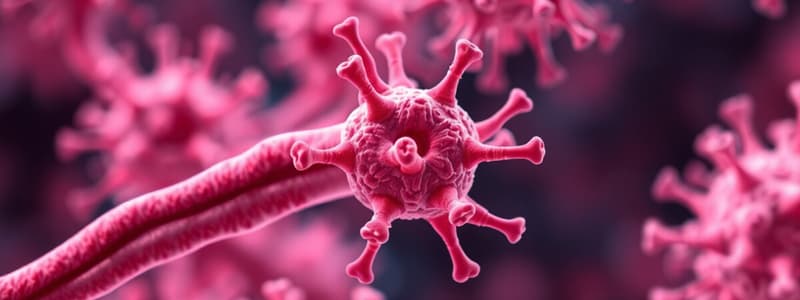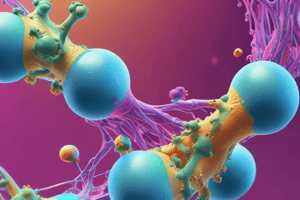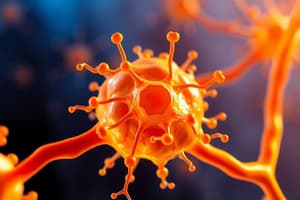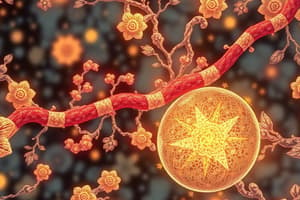Podcast
Questions and Answers
For substances soluble in fat and products of intracellular metabolism, where are the receptors typically located?
For substances soluble in fat and products of intracellular metabolism, where are the receptors typically located?
- Within the cell membrane
- Inside the cell (nucleus or cytosol) (correct)
- In the extracellular matrix
- On the cell surface
Lipid-insoluble substances like amines and amino acids typically bind to receptors located inside the cell.
Lipid-insoluble substances like amines and amino acids typically bind to receptors located inside the cell.
False (B)
What property of a receptor describes its ability to bind only one type of messenger or structurally related messengers?
What property of a receptor describes its ability to bind only one type of messenger or structurally related messengers?
Specificity
The strength with which a messenger binds to its receptor is known as ______.
The strength with which a messenger binds to its receptor is known as ______.
Which of the following describes the degree to which receptors are occupied by messengers?
Which of the following describes the degree to which receptors are occupied by messengers?
T-hormones primarily bind to cytoplasmic receptors.
T-hormones primarily bind to cytoplasmic receptors.
In cytoplasmic receptors, what is the role of chaperon proteins during the ligand-binding process?
In cytoplasmic receptors, what is the role of chaperon proteins during the ligand-binding process?
The sequence on DNA where the receptor-hormone complex binds is known as the ______ sequence.
The sequence on DNA where the receptor-hormone complex binds is known as the ______ sequence.
Match the following steps to their respective receptor types:
Match the following steps to their respective receptor types:
What is the primary function of second messengers in cell signaling?
What is the primary function of second messengers in cell signaling?
Second messengers induce short-term intracellular events without inducing long-term changes.
Second messengers induce short-term intracellular events without inducing long-term changes.
What type of molecule, often mediating receptor activity, phosphorylates target proteins?
What type of molecule, often mediating receptor activity, phosphorylates target proteins?
Cyclic AMP (cAMP) and cyclic GMP (cGMP) are examples of ______ messengers.
Cyclic AMP (cAMP) and cyclic GMP (cGMP) are examples of ______ messengers.
Match the following
Match the following
Which enzyme class is responsible for cleaving phospholipids, producing second messengers like diacylglycerol and inositol trisphosphate?
Which enzyme class is responsible for cleaving phospholipids, producing second messengers like diacylglycerol and inositol trisphosphate?
Receptor channels are a type of membrane receptor that directly catalyze reactions within the cell.
Receptor channels are a type of membrane receptor that directly catalyze reactions within the cell.
What is the primary function of G-protein coupled receptors?
What is the primary function of G-protein coupled receptors?
In G-protein coupled receptors, the exchange of GDP for ______ typically activates the G-protein.
In G-protein coupled receptors, the exchange of GDP for ______ typically activates the G-protein.
What is the function of phosphodiesterase (PDE) in cell signaling?
What is the function of phosphodiesterase (PDE) in cell signaling?
Catalytic receptors are typically enzyme complexes that catalyze reactions after activation.
Catalytic receptors are typically enzyme complexes that catalyze reactions after activation.
What type of catalytic receptor directly catalyzes the conversion of GTP to cGMP?
What type of catalytic receptor directly catalyzes the conversion of GTP to cGMP?
Atrial natriuretic peptide (ANP) is released from atrial cardiomyocytes and causes ______.
Atrial natriuretic peptide (ANP) is released from atrial cardiomyocytes and causes ______.
Insulin primarily binds to which type of receptor?
Insulin primarily binds to which type of receptor?
Receptors coupled to tyrosine kinases directly phosphorylate themselves upon activation.
Receptors coupled to tyrosine kinases directly phosphorylate themselves upon activation.
What molecules do Kinases JANUS/ transcription factors STAT transcribe?
What molecules do Kinases JANUS/ transcription factors STAT transcribe?
Phosphotyrosine phosphatases are a receptors that removes ______ from other proteins
Phosphotyrosine phosphatases are a receptors that removes ______ from other proteins
Match the following receptor functions.
Match the following receptor functions.
What is the primary outcome of receptor internalization (endocytosis)?
What is the primary outcome of receptor internalization (endocytosis)?
Desensitization occurs when a receptor increases its response to a messenger.
Desensitization occurs when a receptor increases its response to a messenger.
What term describes an increase in the total number of receptors for a given ligand?
What term describes an increase in the total number of receptors for a given ligand?
A decrease in the total number of receptors for a given ligand is termed ______.
A decrease in the total number of receptors for a given ligand is termed ______.
Where are intracellular receptors, such as those for steroid hormones, located?
Where are intracellular receptors, such as those for steroid hormones, located?
Activation of cytoplasmic receptors always leads to immediate protein synthesis.
Activation of cytoplasmic receptors always leads to immediate protein synthesis.
What is the general term for receptors that bind to substances that cannot dissolve in lipids?
What is the general term for receptors that bind to substances that cannot dissolve in lipids?
The process by which an extracellular signal triggers the release of calcium ions ($Ca^{2+}$) within a cell is a function of ______.
The process by which an extracellular signal triggers the release of calcium ions ($Ca^{2+}$) within a cell is a function of ______.
Match the membrane chemoreceptors to the signaling cascade they induce
Match the membrane chemoreceptors to the signaling cascade they induce
Which of the following characteristics allow a receptor to bind only one type of messenger (or structurally related messengers)?
Which of the following characteristics allow a receptor to bind only one type of messenger (or structurally related messengers)?
Steroid hormones typically bind to receptors located on the cell membrane.
Steroid hormones typically bind to receptors located on the cell membrane.
The strength with which a messenger binds to its receptor is referred to as ______.
The strength with which a messenger binds to its receptor is referred to as ______.
Which of the following is a primary function of guanylate cyclase receptors (GCRs)?
Which of the following is a primary function of guanylate cyclase receptors (GCRs)?
Briefly describe how a ligand binding to a receptor channel leads to a cellular response.
Briefly describe how a ligand binding to a receptor channel leads to a cellular response.
What is the role of kinases in mediating the effects of membrane receptors?
What is the role of kinases in mediating the effects of membrane receptors?
In the context of receptors, saturation refers to the receptor binding to multiple types of messengers.
In the context of receptors, saturation refers to the receptor binding to multiple types of messengers.
Match each type of membrane receptor with its primary mechanism of action:
Match each type of membrane receptor with its primary mechanism of action:
What is the primary role of phosphodiesterase (PDE) in the context of G protein signaling?
What is the primary role of phosphodiesterase (PDE) in the context of G protein signaling?
Briefly explain the difference between down-regulation and up-regulation of receptors.
Briefly explain the difference between down-regulation and up-regulation of receptors.
Flashcards
What are receptors?
What are receptors?
Proteins that bind chemical messengers to initiate a cellular response.
What are intracellular receptors?
What are intracellular receptors?
Receptors located inside the cell (nucleus or cytosol) that bind to fat-soluble substances.
What are cell membrane receptors?
What are cell membrane receptors?
Receptors located on the cell membrane for lipid insoluble substances.
What is receptor specificity?
What is receptor specificity?
Signup and view all the flashcards
What is receptor affinity?
What is receptor affinity?
Signup and view all the flashcards
What is receptor saturation?
What is receptor saturation?
Signup and view all the flashcards
What are the Cytoplasmic Receptors?
What are the Cytoplasmic Receptors?
Signup and view all the flashcards
What are the Nuclear Receptors?
What are the Nuclear Receptors?
Signup and view all the flashcards
What is a second messenger?
What is a second messenger?
Signup and view all the flashcards
What are Cyclic nucleotides?
What are Cyclic nucleotides?
Signup and view all the flashcards
What are derivatives of membrane lipids?
What are derivatives of membrane lipids?
Signup and view all the flashcards
What are receptor channels?
What are receptor channels?
Signup and view all the flashcards
What are G-protein coupled receptors?
What are G-protein coupled receptors?
Signup and view all the flashcards
What are Catalytic receptors?
What are Catalytic receptors?
Signup and view all the flashcards
What is Guanylate cyclase?
What is Guanylate cyclase?
Signup and view all the flashcards
What are Serine/threonine kinases?
What are Serine/threonine kinases?
Signup and view all the flashcards
What are Tyrosine kinases?
What are Tyrosine kinases?
Signup and view all the flashcards
What are receptors COUPLED to tyrosine kinases?
What are receptors COUPLED to tyrosine kinases?
Signup and view all the flashcards
What are Phosphotyrosine phosphatases?
What are Phosphotyrosine phosphatases?
Signup and view all the flashcards
What is down-regulation?
What is down-regulation?
Signup and view all the flashcards
What is up-regulation?
What is up-regulation?
Signup and view all the flashcards
What is internalization?
What is internalization?
Signup and view all the flashcards
What is desensitization?
What is desensitization?
Signup and view all the flashcards
Study Notes
- Receptors are responsible for receiving chemical messages
Receptors for Chemical Messengers
- Inside the cell (nucleus or cytosol) – substances soluble in fat, products of intracellular metabolism, such as steroid hormones, T-hormones, fatty acids, cholesterol, and prostaglandins
- On the cell membrane – lipid insoluble substances, such as amines, amino acids, peptides, eikosanoids, and purines
Receptor Properties
- Specificity: Receptor (RC) binds only one type of messenger (or structurally related ones)
- Affinity: Strength with which a messenger binds to RC
- Saturation: Degree to which RC is occupied by a messenger
Intracellular Receptors
- Cytoplasmic receptors include steroid hormones, vitamin D, and prostaglandins.
- Nuclear receptors include T-hormones
Cytoplasmic Receptors
- Ligand diffusion across the membrane
- Binding of the ligand to its receptor
- Dissociation of the accompanying protein (chaperone)
- Dimerization of complexes R-H
- Transport of the complex R-H to the nucleus
- Binding of R-H on the HRE sequence of DNA (hormone response element) together with coactivators and RNA-polymerase
- Activation of transcription → synthesis of mRNA
- mRNA diffusion into the cytoplasm
- Translation activation
- Protein synthesis
Nuclear Receptors
- Ligand diffusion across the membrane
- Binding of the ligand to its nuclear receptor in a heterodimer with RXR (retinoid X receptor) – bound to HRE
- Release of corepressor and binding of coactivator and RNA-polymerase on the complex
- Activation of transcription → synthesis of mRNA
- mRNA diffusion into the cytoplasm
- Initiation of translation
- Protein synthesis
Membrane Receptors
- Extracellular messages should be transferred into the intracellular environment – diffusion (Ca2+) or synthesis of the second messenger
- Second messengers mediate immediate intracellular events or induce long-term changes.
- Kinases mediate many of these processes through phosphorylating target proteins (pumps, enzymes, channels, transcription factors).
Second Messengers
- Small diffusible molecules enable the transfer of information from the ECF into the ICF
Types of Second Messengers
- Cyclic nucleotides: cyclic adenosine monophosphate – cAMP – NE, EPI, ADH; cyclic guanosine monophosphate – cGMP – ANP
- Derivatives of membrane lipids: diacylglycerol, inositol trisphosphate (NE, ACh, ADH)
- Ca2+
- Gases (NO/CO/H2S), ROS/RNS
Second Messengers Table
- cAMP; Adenylyl cyclase (AC); protein kinase A (PKA); phosphodiesterases (PDE)
- cGMP; Guanylyl cyclase (GC); protein kinase G (PKG); phosphodiesterases (PDE)
- (Ca2+); Release from ER after IP3 stimulation; calmodulin; Uptake into ER via Ca2+ ATP-ase
- inositol-1,4,5-trisphosphate (IP3); phosphatidylinositol-4,5-bisphosphate (PIP2); phospholipase C (PLC); protein kinase C (PKC); phosphatases – dephosphorylation to inositol
- diacylglycerol (DAG); phosphatidylinositol-4,5-bisphosphate (PIP2); phospholipase C (PLC); protein kinase C (PKC); lipases – production of glycerol and FFA
- phosphatidylinosit ol-3,4,5-trisphosphate (PIP3); phosphatidylinositol-4,5-bisphosphate (PIP2); phosphatidylinositol-3-kinase (PI3K); protein kinase B (PKB); phosphatase PTEN – release of phosphate in position 3
Membrane Chemoreceptors
- Receptor channels
- G-protein coupled receptors
- Catalytic receptors
Receptor Channels, Ligand-Gated Channels
- Ligand binding to the receptor results in a conformational change in the receptor molecule
- This opens the channel, allowing ion diffusion
- Change in MP (IPSP, EPSP)
- Cellular response
- Receptors include GABA (IPSP), glycine (IPSP), glutamic acid (EPSP), Ach (N) (EPSP), serotonin (EPSP), and ATP (EPSP).
G-Protein Coupled Receptors
- G-proteins are GTP-binding proteins with 3 subunits (α, β, and γ), and α subunits that display GTP-ase activity to regulate synthesis of the second messenger
- Types of G-proteins: Gas, Gai, Gaq.
- After GTP binding, βγ subunits dissociate from the G-protein, and processes lead to formation of the activated second messenger
G-Protein Coupled Receptors Action
- Ligand binds to its receptor
- The receptor-ligand complex binds to a G-protein
- G-protein exchanges GDP for GTP
- GTP associated with the G-protein dissociates into subunits α and βγ
- Subunit α activates an enzyme, producing a second messenger. βγ subunits also activate or inhibit membrane proteins (channels, enzymes)
- After GTP splitting by α subunit, complex α-GDP dissociates from the enzyme
- The second messenger is degraded by an enzyme
G Proteins acting via Adenylyl Cyclase
- Adenylyl cyclase (AC) converts ATP into cAMP
- cAMP activates protein kinase A
- PKA phosphorylates downstream proteins.
- cAMP is degraded by phosphodiesterase (PDE) to inactive AMP
G Proteins acting via Phospholipase C
- Phospholipase C (PLC) splits phosphatidylinositol-4,5-bisphospate (PIP2) from the membrane (on phosphodiesterase bond between glycerol and phosphate group)
- Two second messengers (inositol-1,4,5-triphosphate (IP3) and 1,2-diacylglycerol (DAG)) are produced
- DAG activates protein kinase C (PKC), and IP3 releases Ca2+ from the ER
G Proteins acting via Phosphodiesterase
- cGMP is bound to the inner opening of the Na+ channel in the membrane of photoreceptors
- Photoreceptor activation by light leads to stimulation of phosphodiesterase (PDE), cGMP degradation, and closing of the channel
- Decreased flow of cations into the cell (Na channel closed) results in imbalance with relatively higher outflow of cations from the cell (K+ background channels) and membrane hyperpolarization - receptor potential.
G Proteins acting via Phospholipase A2
- Increased intracellular Ca2+ leads to Cyclooxygenase which form Prostaglandins like Vascular effects and Inflammation
- Increased intracellular Ca2+ leads to Lipoxygenase which form Leukotriens like Hypersensitivity and Inflammation
- Cyclooxygenase also produce Tromboxans like Vascular effects and Hemostasis
Regulation of Smooth Muscle Contraction
- Ca++; L-type Ca++ channel cause increased SR Ca+ which releases IP3
- Increased Ca++/CM complex
- GS-R cause ADR
- MLC ATP cause increased MLC
- Guanylate cyclase cause increased CGMP via NO, leading to Relaxation
Catalytic Receptors
- Enzymes or enzyme complexes
- Mostly individual transmembrane proteins
- Frequently form dimers or oligomers after activation
- Differentiation, proliferation, and maturation; vs. Apoptosis, necrosis, and inhibition of growth and maturation
Types of Catalytic Receptors
- Guanylate cyclase
- Serine/threonine kinases
- Tyrosine kinases
- Receptors coupled to tyrosine kinases
- Phosphotyrosine phosphatases
Guanylate Cyclases
- Natriuretic peptides – ANP, BNP, and CNP
- ANP is released from atrial cardiomyocytes during atrial distension, causing vasodilation and natriuresis (decrease in BP)
- BNP is isolated from the porcine brain, but occurs in the heart ventricles and is a marker of heart failure
- CNP is isolated from the porcine brain and causes vasodilation
- The receptor directly catalyses the conversion of GTP to cGMP
Guanylyl Cyclases (GCR)
- There are at least 7 GCRs
- They regulate blood pressure and volume, inhibit cardiomyocyte growth, and are involved in water and ion transport, ossification, and pheromone detection.
Serine-Threonine Kinases
- First cloned in 1991
- Ligands include activins, inhibins, myostatin, bone morphogenetic protein, and TGF-β
- The receptor phosphorylates itself on Ser and Thr residues
Functions of Ser/Thr Kinases (STK)
- They mediate muscle growth and development, bone development, and regulation of hormone secretion
- They are also involved in proliferation, angiogenesis, and apoptosis
- SMAD (transcription activator)
- Regulation of gene expression
Tyrosine Kinases
- Major ligands include insulin, nerve growth factors (NGF, neurotrophins), and epidermal growth factor (EGF)
- The receptor phosphorylates itself on Tyr residues
Insulin
- α
- α
- β
- β
Insulin and what it does
- intermediary metabolism
- growth
- ion balance
Neurotrophic Growth Factors
- NGF (1951, isolation 1956, 1986 NP)
- Essential for neuronal growth and survival
- Secreted by the target organ
Receptors Coupled to Tyrosine Kinases
- Ligands include prolactin and other hormones (growth hormone, erythropoietin), macromolecules or products of microorganisms (PAMP - pathogen-associated molecular patterns) - Toll-like receptors, and tumor necrosis factor (TNF-α)
- Kinases JANUS/ transcription factors STAT (Signal Transducer and Activator of Transcription)
- The receptor is coupled to tyrosine kinase, which phosphorylates it
Growth Hormone (GH)
- Growth
- Intermediary metabolism
- Ionic balance
Phosphotyrosine Phosphatases
- Mainly after 2000
- Ligands include hyaluronic acid, proteins of the extracellular matrix, and other frequently unknown ligands
- The intracellular substrate is a kinase, which is prepared to activation by dephosphorylation
- The receptor removes phosphate from other proteins
CD44
- Cell aggregation and migration
- Lymphocyte activation
- Degradation of hyaluronic acid
- Hemopoiesis
- Angiogenesis
- Cytokine secretion
Down- and Up-Regulation
- Down-regulation: ↓ in total number of receptors for a given ligand with a response to a chronic ↑ in EC concentration of the ligand
- Up-regulation: ↑ in total number of receptors for a given ligand with a response to a chronic ↓ in EC concentration of the messenger
Internalization
- Receptor-mediated endocytosis
- Number of receptors decreases
- Down-regulation or recycling of receptors
Desensitization
- ↓ receptor response to messenger
- Due to high concentration or prolonged exposure to a signalling molecule
- The receptor is uncoupled from its signalling cascade
Studying That Suits You
Use AI to generate personalized quizzes and flashcards to suit your learning preferences.




